
Everything You Need to Know About DHT Blockers
When it comes to hair loss treatments, few topics are discussed as much as DHT blockers. This comprehensive guide covers everything you need to know about DHT blockers, their effects, benefits, risks, and alternatives such as hair transplantation.
Understanding DHT: What Exactly Is It?
DHT, short for dihydrotestosterone, is a hormone that develops from testosterone. While it plays an important role in shaping male physical traits, it also has a notorious side effect—contributing to male pattern hair loss.
Some of the essential roles of the DHT hormone include:
- Deepening of the voice during puberty
- Growth of body and facial hair (beard, mustache)
- Sexual drive and reproductive functions
- Muscle development and bone formation
In short, while DHT is crucial for male sexual and physical development, it can also be problematic by attacking hair follicles, leading to gradual thinning and baldness.
The Role of the DHT Hormone in the Body
The functions of DHT extend beyond hair. Here’s what scientists have discovered about its responsibilities:
- Promotes bone density and structure
- Helps in the production of red blood cells
- Maintains metabolic balance
- Influences sexual behavior and libido
- Supports fetal development and determines the sex of the baby in the womb
- Stimulates muscle mass, beard, and mustache growth
- Plays a role in liver regulation and sperm production
While these functions are vital, an overproduction of DHT can create serious health concerns.
What Happens If DHT Levels Are Too High?
When the body produces excessive DHT, it can lead to conditions such as:
- Benign Prostatic Hyperplasia (BPH)
- Prostate Cancer
- Androgenic Alopecia (Male Pattern Baldness)
- Polycystic Ovary Syndrome (PCOS) in women
High DHT levels are one of the biggest contributors to hair loss, especially in genetically predisposed individuals.
Balancing the DHT Hormone Naturally and Medically
Before diving deeper into DHT blockers, it’s crucial to understand how DHT balance works. Although no definitive cure exists, several methods can help regulate its activity:
- Lifestyle adjustments (diet, exercise, reducing stress)
- Topical lotions and therapeutic applications such as PRP (Platelet Rich Plasma)
- Laser therapies for scalp rejuvenation
- Nutritional improvements (zinc, biotin, and vitamin-rich diets)
- Avoiding habits that trigger hormonal imbalance
Despite these methods, genetics largely determine how hair follicles respond to DHT, which is why DHT blockers are widely used in modern medicine.
Where Can You Get a DHT Test?
If you suspect hormonal imbalance, you can request a DHT test. Usually, these tests are performed in the endocrinology department, but you may first visit an internal medicine doctor, who can then refer you to a specialist.
Why Does DHT Cause Hair Loss?
Research confirms that testosterone is converted into DHT within hair follicles. In men with a genetic predisposition, this causes androgenic alopecia or male pattern baldness. Essentially, DHT binds to receptors in hair follicles, shrinking them over time, leading to thinning hair and eventual baldness.
This discovery led to the development of DHT blockers—substances designed to prevent DHT from attaching to hair follicles, thereby reducing hair loss.
What Are DHT Blockers and How Do They Work?
DHT blockers are substances that stop DHT from binding to receptors in the scalp. By interfering with this process, they help preserve hair growth.
There are three main types of DHT blockers:
- Prescription Medicines
- Shampoos and Conditioners
- Natural Foods and Supplements
Let’s look at each in detail.
Prescription Medicines as DHT Blockers
The most popular prescription DHT blocker is Finasteride, commonly sold under the brand name Propecia.
- Finasteride works by inhibiting the enzyme that converts testosterone into DHT.
- Taken daily as a pill, it can slow down hair loss and even promote regrowth.
- However, its effects are temporary—stopping the medication will restart hair loss.
For women, Spironolactone is sometimes prescribed as an alternative, although it works differently and is generally not recommended during reproductive years.
Finasteride in Detail
- Available in tablet form
- Shown in studies to reduce DHT levels by up to 60%
- 90% of men in clinical trials reported reduced hair loss
- Must be taken daily for continued results
- Marketed as Propecia or in generic forms
Other Medications for Hair Loss
Although Minoxidil (Rogaine/Regaine) is not technically a DHT blocker, it is a popular over-the-counter solution that stimulates hair growth. Unlike Finasteride, its exact mechanism isn’t fully understood, but studies show success in more than 60% of users.
Shampoos and Conditioners as DHT Blockers
If you prefer topical treatments, DHT-blocking shampoos and conditioners may be an option. Look for products containing:
- Ketoconazole
- Saw Palmetto
- Pyrithione Zinc
These ingredients help reduce scalp DHT activity and may improve hair density over time.
Natural DHT Blockers: Foods and Vitamins
Some patients prefer natural remedies. Popular options include:
- Saw Palmetto extract
- Pumpkin seeds
- Green tea
- Nettle root
Although these are widely marketed as natural DHT blockers, scientific evidence remains limited. They are generally safe but should not replace clinically proven treatments.
Using DHT Blockers for Hair Loss
To see results with Finasteride (Propecia) or Minoxidil (Rogaine), you need consistent, long-term use (usually 3–6 months before visible improvements). However, once discontinued, the benefits fade quickly, and hair loss resumes.
Possible Side Effects of DHT Blockers
While effective, DHT blockers are not risk-free. Some reported side effects include:
- Reduced libido or erectile dysfunction
- Gynecomastia (male breast tissue growth)
- Testicular discomfort
- Skin rashes
- Liver enzyme changes
Sexual Side Effects
Propecia can cause decreased sexual desire, erectile dysfunction, or reduced sperm volume. These effects are rare (about 1 in 100 users) but should be considered before committing to daily, long-term use.
Breast Tissue Growth (Gynecomastia)
Some men report male breast enlargement while taking Finasteride, though cases are rare.
Testicular Issues and Skin Reactions
A few users experience testicular tenderness, pain during urination, or rashes on the scalp and body.
Liver Enzyme Elevation
Occasionally, Propecia use may raise liver enzymes detected in blood tests. While not usually serious, patients should consult their doctor if concerned.
Who Should Avoid DHT Blockers?
DHT blockers are not suitable for everyone. They should be avoided by:
- Women with hair loss unrelated to DHT
- Men under 18 years old
- Patients undergoing PSA (prostate-specific antigen) tests
- Individuals with severe heart or skin conditions
Why Hair Transplant May Be a Better Option
While DHT blockers can slow down or temporarily reverse male pattern baldness, they are not a permanent solution. On the other hand, hair transplant surgery offers lasting results.
Benefits of Hair Transplantation
- Permanent Results – Healthy donor hair follicles are resistant to DHT and remain intact for life.
- Cost-Effective in the Long Term – One-time treatment with lifelong results.
- High Success Rates – Success rates above 95–99% in skilled hands.
- Quick Recovery – Healing usually takes 7–10 days.
- Low Maintenance – Transplanted hair can be treated just like natural hair.
Everything You Need to Know About DHT Blockers
Everything You Need to Know About DHT Blockers is that while they can be effective in slowing hair loss, they are not a miracle cure. Finasteride (Propecia) and Minoxidil (Rogaine) are the only clinically proven options, but they come with potential side effects and require lifelong use.
For those seeking a permanent solution, hair transplantation remains the most reliable method with long-term success.

